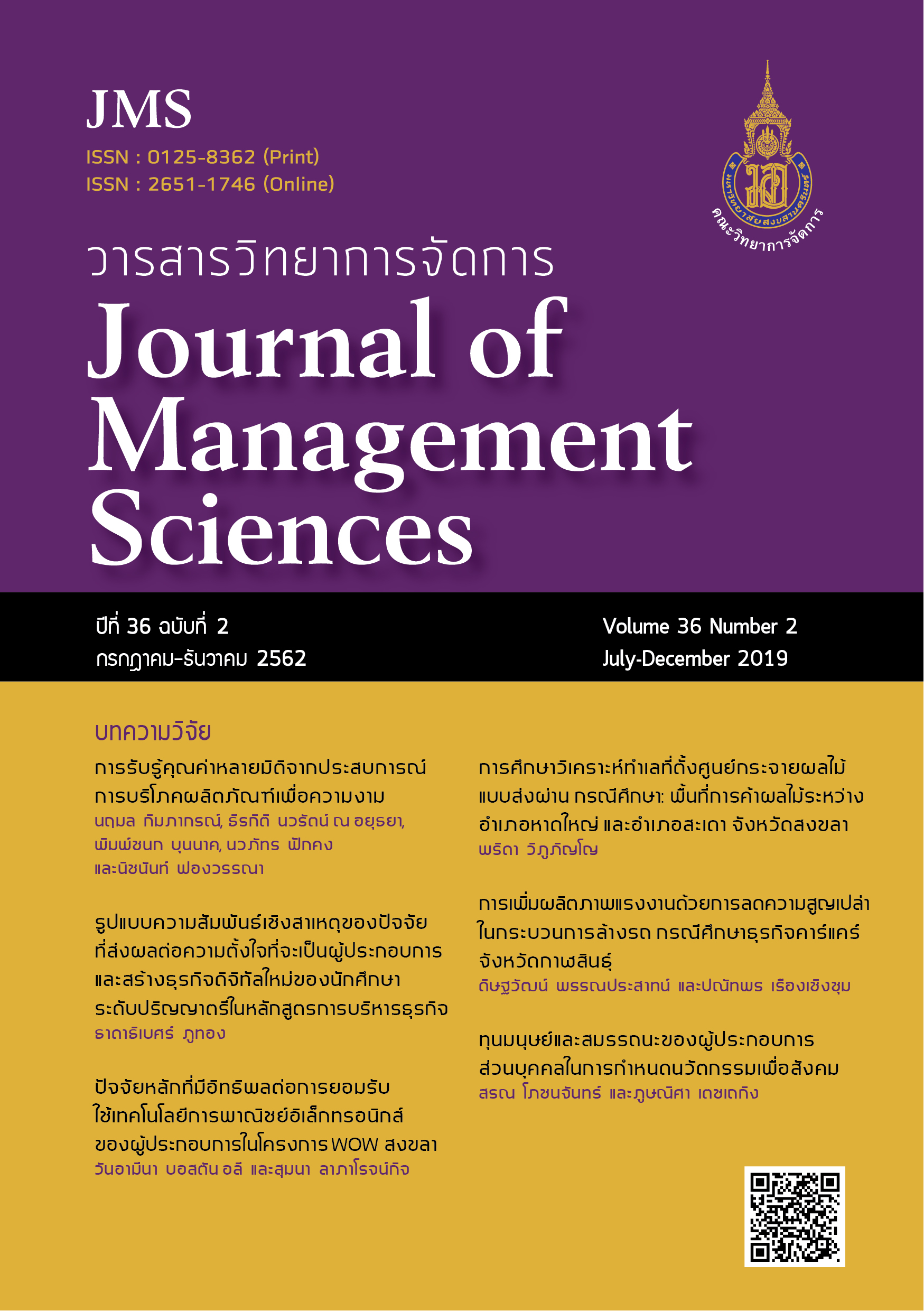ปัจจัยหลักที่มีอิทธิพลต่อการยอมรับใช้เทคโนโลยีการพาณิชย์อิเล็คทรอนิกส์ของผู้ประกอบการในโครงการ WOW สงขลา
Main Article Content
บทคัดย่อ
การศึกษาวิจัยนี้มีวัตถุประสงค์เพื่อศึกษาโมเดลสมการเชิงโครงสร้างของปัจจัยที่มีผลต่อการยอมรับเทคโนโลยีพาณิชย์อิเล็กทรอนิกส์ของบริษัทขนาดกลางและขนาดย่อมในจังหวัดสงขลา เนื่องด้วยในปัจจุบันธุรกิจขนาดกลางและขนาดย่อมบางส่วนในประเทศไทยยังคงขาดการตระหนักถึงการใช้เทคนิคและเทคโนโลยีทางพาณิชย์อิเล็กทรอนิกส์ งานวิจัยนี้ใช้การประยุกต์ทฤษฎีการยอมรับและการใช้เทคโนโลยี เพื่อวิเคราะห์องค์ประกอบที่ส่งผลต่อการพาณิชย์อิเล็กทรอนิกส์ และได้ใช้แบบจำลองทฤษฎีการยอมรับและการใช้เทคโนโลยี (UTAUT) ในการทดสอบการยอมรับและการใช้เทคโนโลยีใหม่ โดยใช้แบบสอบถามในการเก็บข้อมูลเชิงปริมาณจากบริษัทที่มีพนักงานมากกว่าสิบคนในจังหวัดสงขลา และใช้โปรแกรม SmartPLS ในการวิเคราะห์ข้อมูล ผลการวิจัยพบว่า ปัจจัยความคาดหวังด้านประสิทธิภาพมีผลต่อความตั้งใจใช้เทคโนโลยีในอนาคตมากที่สุด นอกจากนี้ ปัจจัยความคาดหวังในการใช้งานและปัจจัยการรับรู้ความน่าเชื่อถือก็ส่งผลในเชิงบวกต่อความตั้งใจใช้เทคโนโลยีเช่นกัน แต่ในทางตรงกันข้าม ปัจจัยความสมัครใจไม่ส่งผลต่อการยอมรับใช้เทคโนโลยี ผลจากงานวิจัยนี้ชี้ให้เห็นถึงความสำคัญในการเข้าใจปัจจัยที่ส่งผลต่อบริษัทในการใช้เทคโนโลยี และมีข้อเสนอแนะสำหรับบริษัทท้องถิ่นในการที่จะใช้พาณิชย์อิเล็กทรอนิกส์เพื่อสร้างโอกาสและความได้เปรียบในการแข่งขันต่อไป
Article Details

อนุญาตภายใต้เงื่อนไข Creative Commons Attribution-NonCommercial-NoDerivatives 4.0 International License.
บทความที่ตีพิมพ์ถือเป็นลิขสิทธิ์ของวารสารวิทยาการจัดการ มหาวิทยาลัยสงขลานครินทร์ อย่างไรก็ตาม กองบรรณาธิการไม่สงวนลิขสิทธิ์ในการทำซ้ำ คัดลอก หรือเผยแพร่ แต่จะต้องอ้างอิงให้ถูกต้องตามหลักวิชาการ
เอกสารอ้างอิง
Ajao, B. F., Oyebisi, T. O., & Aderemi, H. O. (2018). Factors influencing the implementation of e-commerce innovations: The case of the Nigerian informal sector. African Journal of Science, Technology, Innovation and Development, 10(4), 473-481.
AlAwadhi, S., & Morris, A. (2008). The use of the UTAUT Model in the adoption of e-government services in Kuwait. In Hawaii International Conference on System Sciences, Proceedings of the 41st Annual (pp. 219-219). IEEE.
Alkhunaizan, A., & Love, S. (2012). What drives mobile commerce? An empirical evaluation of the revised UTAUT model. International Journal of Management and Marketing Academy, 2(1), 82-99.
Cao, Y., Ajjan, H., Hong, P., & Le, T. (2018). Using social media for competitive business outcomes: An empirical study of companies in China. Journal of Advances in Management Research, 15(2), 211-235.
Dulle, F. W., & Minishi-Majanja, M. K. (2011). The suitability of the Unified Theory of Acceptance and Use of Technology (UTAUT) model in open access adoption studies. Information Development, 27(1), 32-45.
Fornell, C., & Larcker, D. F. (1981). Evaluating structural equation models with unobservable variables and measurement error. Journal of Marketing Research, 18(1), 39-50.
Frambach, R. T., & Schillewaert, N. (2002). Organizational innovation adoption: A multi-level framework of determinants and opportunities for future research. Journal of Business Research, 55(2), 163-176.
Hair Jr, J. F., Hult, G. T. M., Ringle, C., & Sarstedt, M. (2016). A primer on partial least squares structural equation modeling (PLS-SEM). Sage publications.
Hair, J. F., Ringle, C. M., & Sarstedt, M. (2011). PLS-SEM: Indeed a silver bullet. Journal of Marketing Theory and Practice, 19(2), 139-152.
Hart, P., & Saunders, C. (1997). Power and trust: Critical factors in the adoption and use of electronic data interchange. Organization Science, 8(1), 23-42.
Hock, C., Ringle, C. M., & Sarstedt, M. (2010). Management of multi-purpose stadiums: Importance and performance measurement of service interfaces. International Journal of Services Technology and Management, 14(2-3), 188-207.
Kfouri, G., & Skyrius, R. (2016). Factors influencing the implementation of business intelligence among small and medium enterprises in Lebanon. Informacijos Mokslai, 76, 96-110.
Khemthong, S., & Roberts, L. M. (2006). Adoption of Internet and web technology for hotel marketing: a study of hotels in Thailand. Journal of Business Systems, Governance, and Ethics, 1(2), 47-60.
Kumar, S., Luthra, S., & Haleem, A. (2015). Benchmarking supply chains by analyzingtechnology transfer critical barriers using AHP approach. Benchmarking: An International Journal, 22(4), 538-558.
Legris, P., Ingham, J., &Collerette, P. (2003). Why do people use information technology? A critical review of the technology acceptance model. Information & Management, 40(3), 191-204.
Lu, J., Yu, C. S., Liu, C., & Yao, J. E. (2003). Technology acceptance model for wireless internet. Internet Research,13(3), 206-222.
Mathieson, K., Peacock, E., & Chin, W. W. (2001). Extending the technology acceptance model: The influence of perceived user resources. ACM SigMIS Database, 32(3), 86-112.
Oliveira, T., & Martins, M. F. (2010). Understanding e-business adoption across industries in European countries. Industrial Management & Data Systems, 110(9), 1337-1354.
San Martín, H., &Herrero, Á. (2012). Influence of the user’s psychological factors on the online purchase intention in rural tourism: Integrating innovativeness to the UTAUT framework. Tourism Management, 33(2), 341-350.
Saekow, A., & Samson, D. (2011). E-learning Readiness of Thailand's Universities Comparing to the USA's Cases. International Journal of e-Education, e-Business, e-Management and e-Learning, 1(2), 126.
Shaharuddin, N. A., Rahman, A. A., Aziz, Y. A., & Kassim, S. (2018). An assessment of web technologies & e-business adoption among SMEs travel agencies in Malaysia. Journal of Academia UiTMNegeri Sembilan Vol, 6(1), 89-96.
Sin T. K., Choy C. S., Lin, B., & Cyril E. U. (2009). Internet-based ICT adoption: Evidence from Malaysian SMEs. Industrial Management & Data Systems, 109(2), 224-244.
Surbakti, F. P. S., Wang, W., Indulska, M., & Sadiq, S. (2019). Factors influencing effective use of big data: A research framework. Information & Management.
Vatanasakdakul, S., Tibben, W., & Cooper, J. (2004). What prevent B2B eCommerce adoption in developing countries?: a socio-cultural perspective. 17th Bled eCommerce Conference on eGlobal (pp. 1-15).
Venkatesh, V. (2000). Determinants of perceived ease of use: Integrating control, intrinsic motivation, and emotion into the technology acceptance model. Information Systems Research, 11(4), 342-365.
Venkatesh, V., Davis, F. D., & Morris, M. G. (2007). Dead or alive?The development, trajectory and future of technology adoption research. Journal of the Association for Information Systems, 8(4), 267-286.
Venkatesh, V., Morris, M.G., Davis, F.D., and Davis, G.B. (2003).“User Acceptance of Information Technology: Toward a Unified View,” MIS Quarterly, 27, 425-478.
Venkatesh, V., & Morris, M. G. (2000). Why don't men ever stop to ask for directions? Gender, social influence, and their role in technology acceptance and usage behavior. MIS Quarterly, 115-139.
Williams, M. D., Rana, N. P., & Dwivedi, Y. K. (2015). The unified theory of acceptance and use of technology (UTAUT):
a literature review. Journal of Enterprise Information Management, 28(3), 443-488.
Yu, C. S. (2012). Factors Affecting Individuals to Adopt Mobile Banking: Empirical Evidence from the UTAUT Model. Journal of Electronic Commerce Research, 13(2), 104-121.
Zainab, B., Awais Bhatti, M., & Alshagawi, M. (2017). Factors affecting e-training adoption: an examination of perceived cost, computer self-efficacy and the technology acceptance model. Behaviour & Information Technology, 36(12), 1261-1273.
Zhu, K., & Kraemer, K. L. (2005). Post-adoption variations in usage and value of e-business by organizations: cross-country evidence from the retail industry. Information Systems Research, 16(1), 61-84.

